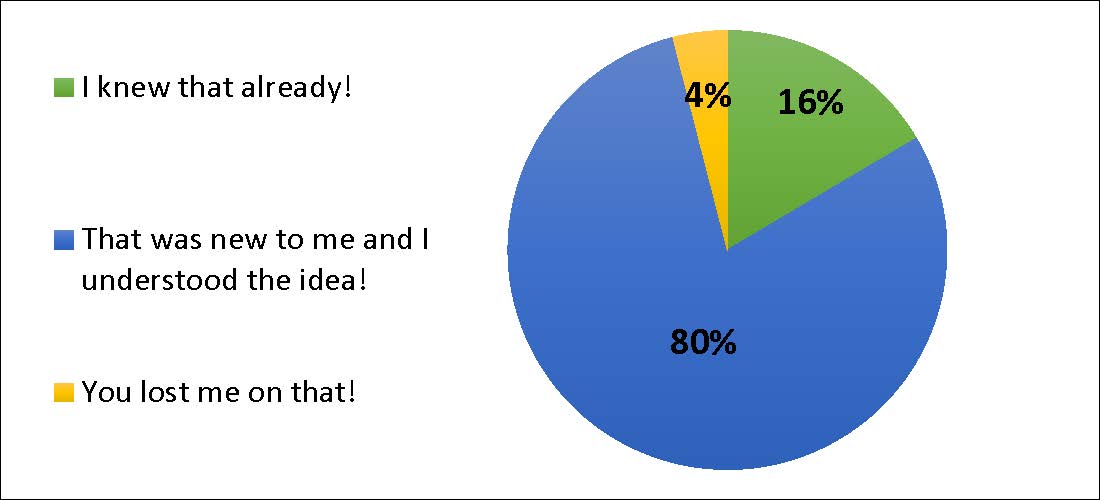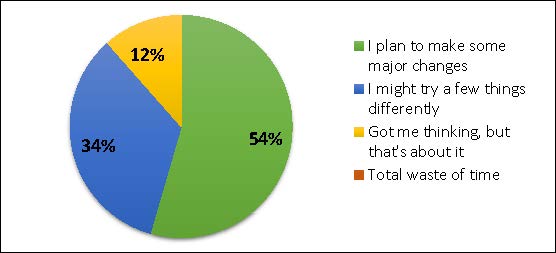Journal of the NACAA
ISSN 2158-9429
Volume 12, Issue 2 - December, 2019
Alfalfa in the South Workshop Series: Increasing Acreage through Education
- Tucker, J. J., Assistant Professor , University Of Georgia
Hendricks, T.J., PhD Graduate, University of Georgia
Mason, K.B., PhD Candidate, Auburn University/Alabama Extension System
Mullenix M.K., Associate Professor - Extension Specialist, Auburn University/Alabama Extension System
Prevatt, C.G., State Specialized Extension Agent II, UF IFAS Range Cattle Research and Education Center
Hancock, D.W., Professor - Extension Specialist, University of Georgia
ABSTRACT
The ‘Alfalfa in the South’ workshop series is designed to provide in-depth Extension education to innovative early adopter producers to increase awareness, knowledge, and production acreage in the South. One-day workshops were developed and repeated in five locations across Alabama and Georgia in 2018-2019 through collaboration between University of Georgia Extension, Alabama Extension, UF/IFAS Extension, and America’s Alfalfa®. These workshops included a half-day classroom session with focused learning modules, and an afternoon field visit to provide real-time discussion with producer collaborators and shared experiences among attendees. Evaluations determined that attendees improved their knowledge base and 88% of survey respondents were likely to implement changes in their operation using alfalfa in the coming year as a result of attending this program.
INTRODUCTION
In the early 1900's alfalfa was the dominant perennial legume species used in the southern region of the US, however, the harsh environment and elevated insect pressure soon eliminated many productive alfalfa stands and acreage declined significantly by the 1960's (Lacefield et al., 2009). The success and adoption of alfalfa in the North and Midwest is in part due to improved variety development for these regions, providing higher yields and improved quality potential. Although alfalfa is considered a minor crop in the South, the potential for integration into existing forage systems is high. However, there are still significant on-farm management and social perceptions that must be overcome for adoption of alfalfa plantings and acreage to increase in the southern US. Legume integration in warmer-climate regions has historically been limited by 1) perceived lack of persistence, 2) lack of awareness of adapted varieties, and 3) knowledge of management requirements (Shelton et al., 2000). Newer alfalfa varieties have been developed with improved adaptation to hot, humid growing conditions of the South with dual use purposes (hay and grazing) that better fit the management opportunities for forage-livestock farmers in the region. While the increase of alfalfa acreage in other regions of the US has been relatively flat in recent years (USDA NASS, 2017), there is a measurable increase in alfalfa educational efforts, plantings, and adoptions in the Southeast US in the last five years.
During this time period, based on reported seed sales in Georgia, approximately 28,000 acres of alfalfa have been planted in the region (America’s Alfalfa and Athens Seed Company, personal communication, 2019).Extensive educational efforts have been established promoting the use of alfalfa as a viable high-quality forage option in the South. The “Alfalfa in the South” workshop series was designed to provide in-depth Extension education, circulate new research findings, and engage in meaningful discussions with producers as related to the use of alfalfa in the South.
METHODS
The ‘Alfalfa in the South’ workshop was designed as a one-day Extension education event focused on in-depth discussion of alfalfa establishment, management, and utilization in the South. This program was a joint effort as part of a USDA-NIFA Alfalfa and Forage Research Program grant between the University of Georgia Extension, Alabama Extension, UF/IFAS Extension, and forage industry representatives from America’s Alfalfa®. Five, one-day workshops were held in 2018 and 2019 in Georgia and Alabama. These workshops were advertised through local county Extension offices, through collaboration with commodity groups within each state, and online via university websites, electronic newsletters and social media (Facebook and Twitter).
These one-day workshops were designed for a target audience of advanced, innovative, early adopter producers who were actively pursuing the idea of alfalfa establishment within the coming production season. The goals of the program were (1) to provide in-depth extension education on alfalfa production systems, going beyond the basics; (2) to highlight current research; and (3) to engage in meaningful discussions with producers relating to the use of alfalfa in the South.
The program included 2 parts:
- A full morning session of classroom education
- An afternoon field visit and outdoor discussion of alfalfa production at university or private on-farm settings
Workshop learning module topics covered during the classroom education sessions included:
- Getting Started: Site Selection, Variety Selection, and Establishment
- Management: Weed and Insect Control, Fertilization, Persistence
- Improving Animal Performance with Alfalfa
- New Research Information: Alfalfa Breeding Program, Update of Current projects in the region
- Economics and Establishment Budgets
- Producer discussion: Hot Topics, Burning Questions, Personal Experiences
Each 30 minute presentation was delivered by university faculty or graduate students actively engaged in regional alfalfa management research. Topics were chosen to provide a stair-step approach and equip producers with the information needed to establish and manage alfalfa in southeastern forage-livestock operations.
On-farm field visits included producer demonstration locations previously established with early adopter producers in conjunction with University Extension and America’s Alfalfa®. These producer collaborations and demonstration locations played a vital role in dissemination of information as these producers were able to share in real-time their personal and unique experience with alfalfa production on their farms. This provided a visual, tangible perspective for producers considering adoption of alfalfa as part of their management system.
Program content was archived online from the 2018 workshops to serve as a reference for those seeking information on alfalfa management in the region, and further expand the reach of this information to clientele. The full 2018 program notebook is available for download at https://georgiaforages.caes.uga.edu/event/2018-alfalfa-workshops.html. Videos of 2018 program modules can be found online at https://youtu.be/cafMcLxmKJQ.
PROGRAM PARTICIPATION AND RESULTS
Target audience attendance for the program was at minimum 10 participants and no more than 50 at each location. Workshops were designed to create an environment for open discussion among participants who were actively pursuing the idea of planting alfalfa. Participation at each location varied due to workshop location and number of early adopter forage producers in the region (Table 1). Participation in Alma, GA (8) was less than our target, however all of the attendees were early adopters whom had recently planted or were preparing to established alfalfa on their operations in the following growing season. Participation in Troy, AL was higher than all locations in Georgia, this is the direct effect of having only one workshop in 2019, rather than 4 repeated workshops within the same region of the state. It is worth mentioning that the popularity of the Georgia programs directly influenced attendance the following year, and the Alabama workshop was advertised as the only 'Alfalfa in the South' workshop to be held in 2019.
Each participant was asked to complete a post-workshop evaluation form (n=81). Evaluations were conducted to determine producer perceptions of overall program organization, change in knowledge regarding alfalfa management, effectiveness of individual modules/topics covered, and potential adoption of the use of alfalfa on their farms. The post-program survey was designed using a mix of question organization and methodologies including multiple choice, percentage evaluation, a Likert-style 1 to 5 scale (poor to good) or change in knowledge (no change to greatly improved), and open ended questions.
| Date | Location | Attendees |
|---|---|---|
|
May 1, 2018 |
Edison, GA |
16 |
| May 8, 2018 | Alma, GA |
8 |
| May 9, 2018 | Tifton, GA |
11 |
| May 10, 2018 | Irwinville, GA |
10 |
| May 7, 2019 | Troy, AL |
41 |
| Total |
86 |
Review of Workshop Development and Content:
Content evaluations determined that the workshop was well developed, organized, and presented without being overwhelming to participants. Evaluation results determined that the workshop met or exceeded expectations (4.5), with good presentation style and delivery (4.1), was well-organized (4.8), and provided a good amount of information (3.6) (Figure 1).
 Figure 1. Participant perception of workshop content and delivery
Figure 1. Participant perception of workshop content and delivery
Further, evaluation results determined that the information provided reached participants at the target level of providing new information that was easily understood (Figure 2).

Figure 2. Participant perception of information provided throughout the workshop
Overall participants preferred the field tours and producer discussion to all other modules (4.7), however all modules and topics covered received very good to excellent ratings (4.1 to 4.7).
Participant change:
On a scale of 1 to 5, where 1 was ‘no change’ and 5 indicated ‘greatly improved’, participants determined that their change in knowledge, interest in using alfalfa, and their confidence in using alfalfa management skills all greatly improved after this workshop (4.4, 4.6, and 4.3, respectively).
When asked what they planned to do differently in their operation producers responded:
- “Integrate alfalfa not only into hay production by also into grazing on a rotational system.”
- “Evaluate my input costs more closely”
- “Incorporate alfalfa into existing bermudagrass stands”
- “Plant alfalfa!”
When asked how this workshop has helped the attendee, responses included:
- “Helped in planning for future grazing of cattle and planning for nutritional needs”
- “Has really helped us understand how to get started, how to go about it, and got me ready to start!”
- “Just getting started – this workshop helped 100%”
Finally, post-workshop evaluations determined that 34% of participants indicated that they might try a few things differently while 54% plan to make some major changes (Figure 3), which demonstrates potential plans for adoption of one or more of the management practices discussed during the workshops.

Figure 3. Likelihood of operational change as a result of this meeting.
CONCLUSIONS AND FUTURE DIRECTIONS
Through targeting early adopter producers and the collaboration and on-farm demonstrations these programs were able to provide in-depth information on alfalfa management to producers in the southeastern region of the US. Program organizers plan to continue this collaboration through regional, next-step research efforts, and dissemination of those findings through integrated in-classroom and field-based educational programs. Demonstration projects with innovative producers, such as those who were partners as part of the educational delivery in these workshops, help reduce hesitation among producers and improve producer awareness and consideration of management practices in on-farm settings. Future programming efforts plan to include and emphasize direct discussion with active alfalfa producers as a more defined part of the program. At all locations, the producer-led portion of the program generated the greatest amount of discussion and interaction among attendees, while also re-emphasizing much of the information presented during the in-classroom portion by Extension specialists. Information presented as part of this program, and feedback from stakeholders through surveys will help refine future Extension program efforts on alfalfa in the South targeted towards a more broad audience of forage-livestock producers who may be unfamiliar with alfalfa management systems.
ACKNOWLEDGMENTS
Support for this program provided through USDA-NIFA-Alfalfa Forage Research Program grant #2017-70005-27089, the Georgia Commodity Commission for Beef, and America’s Alfalfa®.
REFERENCES
Lacefield, G.D., D.M. Ball, D. Hancock, J. Andrae, and R. Smith. (2009). Growing Alfalfa in the South. National Alfalfa and Forage Alliance.
Shelton, H., S. Franzel, and M. Peters. (2005). Adoption of tropical legume technology around the world: Analysis of success. Tropical Grasslands. 39:198-209.
